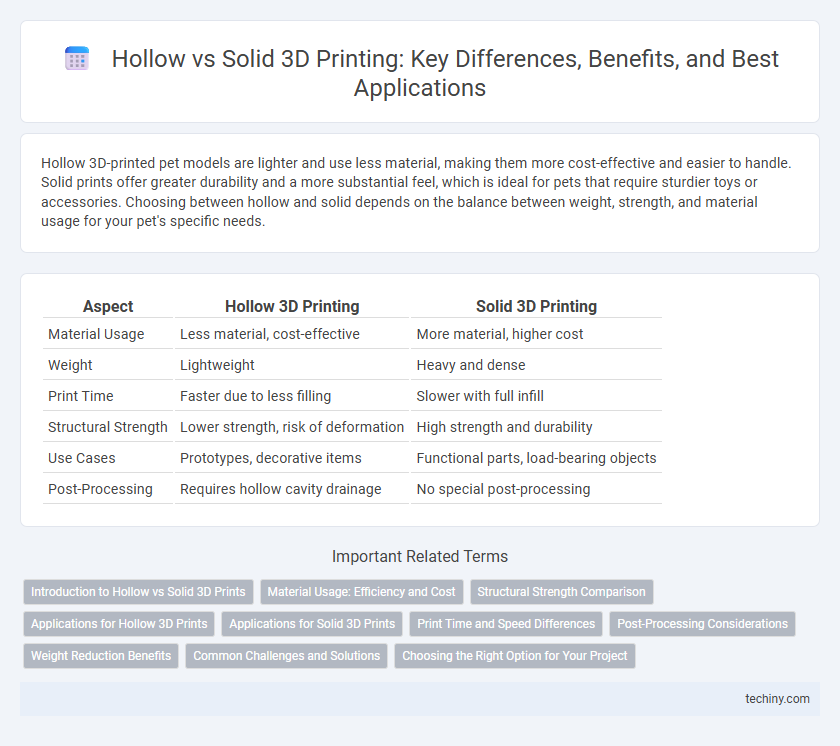Hollow 3D-printed pet models are lighter and use less material, making them more cost-effective and easier to handle. Solid prints offer greater durability and a more substantial feel, which is ideal for pets that require sturdier toys or accessories. Choosing between hollow and solid depends on the balance between weight, strength, and material usage for your pet's specific needs.
Table of Comparison
| Aspect | Hollow 3D Printing | Solid 3D Printing |
|---|---|---|
| Material Usage | Less material, cost-effective | More material, higher cost |
| Weight | Lightweight | Heavy and dense |
| Print Time | Faster due to less filling | Slower with full infill |
| Structural Strength | Lower strength, risk of deformation | High strength and durability |
| Use Cases | Prototypes, decorative items | Functional parts, load-bearing objects |
| Post-Processing | Requires hollow cavity drainage | No special post-processing |
Introduction to Hollow vs Solid 3D Prints
Hollow 3D prints contain internal cavities that reduce material usage and printing time, making them cost-effective for large models. Solid 3D prints offer maximum strength and durability, suitable for functional parts requiring structural integrity. Choosing between hollow and solid depends on the application's balance of weight, strength, and material efficiency.
Material Usage: Efficiency and Cost
Hollow 3D prints significantly reduce material usage, leading to lower production costs and faster print times compared to solid counterparts. By optimizing infill density and wall thickness, manufacturers achieve a balance between structural integrity and resource efficiency. Solid prints, while sturdier, demand more filament, resulting in higher expenses and longer manufacturing cycles.
Structural Strength Comparison
Hollow 3D printed objects reduce material usage and printing time but often compromise structural strength compared to solid counterparts. Solid prints exhibit superior load-bearing capacity and resistance to impact due to uniform material distribution. In applications demanding maximum durability, solid models are preferred for their enhanced mechanical performance.
Applications for Hollow 3D Prints
Hollow 3D prints are ideal for applications requiring weight reduction and material savings, such as lightweight drone components, customized prosthetics, and ergonomic product prototypes. These prints improve thermal insulation and reduce printing times, making them suitable for aerospace parts and large-scale architectural models. The hollow structure also enhances fluid flow in biomedical devices and functional enclosures where internal channels are necessary.
Applications for Solid 3D Prints
Solid 3D prints provide enhanced structural integrity ideal for load-bearing components in aerospace, automotive, and medical implant industries. These prints ensure maximum durability and resistance to stress, making them suitable for functional prototypes and end-use parts requiring high strength. Common applications include gears, prosthetics, and custom tools where material density directly impacts performance and longevity.
Print Time and Speed Differences
Hollow 3D prints significantly reduce print time and increase printing speed by minimizing the internal material deposition compared to solid prints. Solid prints require longer print durations due to the complete infill and denser layering, which increases material usage and slows down the printing process. Optimizing print speed involves balancing structural integrity with hollow sections to achieve efficient production without compromising durability.
Post-Processing Considerations
Hollow 3D prints reduce material usage and printing time but require thorough internal cleaning to remove support material or debris, which can be challenging without accessible openings. Solid prints offer greater structural integrity and simplify post-processing steps like sanding and painting, as there are no internal cavities to contend with. Choosing between hollow and solid designs significantly impacts the ease and complexity of post-processing workflows, affecting overall print quality and durability.
Weight Reduction Benefits
Hollow 3D printed objects significantly reduce weight compared to solid counterparts by minimizing material usage while maintaining structural integrity. This weight reduction enhances efficiency in applications such as aerospace, automotive, and wearable technology, where lighter components improve performance and fuel economy. Optimizing infill patterns and wall thickness further balances strength and weight savings, making hollow designs ideal for lightweight manufacturing solutions.
Common Challenges and Solutions
Hollow 3D prints often face challenges such as structural weakness and difficulty in draining excess resin or filament, leading to print failures. Solid prints provide enhanced durability and stability but consume more material and increase print time significantly. Optimizing infill patterns and wall thickness can balance material use and strength, while incorporating drainage holes in hollow designs prevents trapped residue and improves print quality.
Choosing the Right Option for Your Project
Choosing between hollow and solid 3D printing depends on the project's structural requirements and material usage. Hollow models reduce weight and material costs, ideal for prototypes or decorative pieces, while solid prints offer greater strength and durability needed for functional parts. Evaluating the balance between mechanical stress, aesthetic needs, and budget constraints ensures the right printing option is selected.
Hollow vs Solid Infographic

 techiny.com
techiny.com